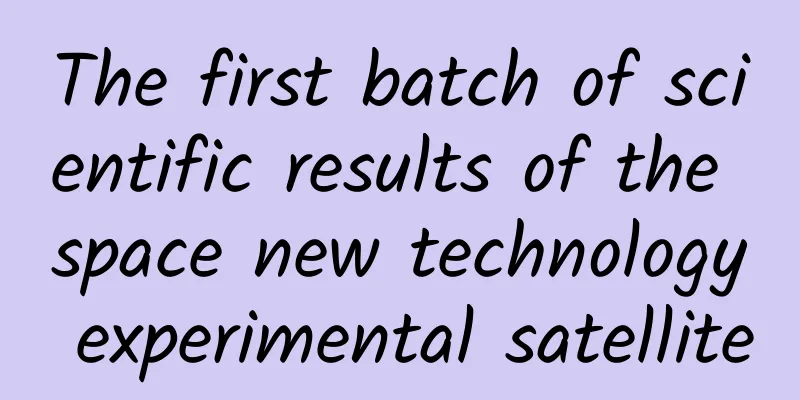The first batch of scientific results of the space new technology experimental satellite

|
On September 5, the reporter learned from the Chinese Academy of Sciences that the new space technology experimental satellite, which was sent into the predetermined orbit by the Lijian-1 carrier rocket on July 27, is currently operating normally. The multiple scientific payloads on board the satellite have been tested as planned and the first batch of scientific results have been obtained. The New Space Technology Experimental Satellite is the first satellite of the "Innovation X" series developed by the Microsatellite Innovation Institute of the Chinese Academy of Sciences. According to the plan, it will carry out flight verification of more than 20 new payloads and new technology products. The first wide-field X-ray focused imaging sky map The Lobster-Eye wide-field X-ray telescope on board the satellite successfully obtained a number of real X-ray measured images and energy spectra of celestial bodies. This is the first time that a wide-field X-ray focused imaging sky map has been obtained and publicly released in the world. According to reports, the telescope was jointly developed by the National Astronomical Observatory of the Chinese Academy of Sciences and the Shanghai Institute of Technical Physics of the Chinese Academy of Sciences. It has an observation field of view of up to 340 square degrees and is the world's first wide-field X-ray focusing imaging telescope. Compared with other similar telescopes, its field of view has been increased by at least 100 times. Scientists used the telescope to observe the central region of the Milky Way. The results showed that a single observation can simultaneously obtain X-ray sources in different directions in a large field of view, including stellar mass black holes and neutron stars. The observation also captured a neutron star X-ray binary system with X-ray radiation brightened several times. At the same time, the data can also provide information on how the X-ray radiation intensity of these celestial bodies changes over time, as well as the X-ray energy spectrum of the celestial bodies. Establishing a gamma-ray burst detection network The High Energy Burst Explorer (HEBS), a gamma-ray burst detection payload developed by the Institute of High Energy Physics of the Chinese Academy of Sciences, has been powered on for the first time and started on-orbit testing. Existing test results have shown that HEBS is working normally on-orbit, laying a solid foundation for subsequent testing, calibration and analysis of burst events. During the on-orbit test, HEBS detected its first gamma-ray burst since its operation, indicating that HEBS has the ability to detect and study gamma-ray bursts. HEBS, together with the previously launched Insight-HXMT satellite and Huairou-1 satellite, has formed a gamma-ray burst celestial body detection network. "The simultaneous observations of the wide-field X-ray telescope and HEBS in the same field of view are very exciting, especially for new explosive objects and phenomena. Not only can we obtain X-ray and gamma-ray energy spectra and light variations in a very wide energy range, but the X-ray telescope can also accurately locate them. This capability is currently unique in the world, and exciting scientific discoveries are expected." said Zhang Shuangnan, a researcher at the Institute of High Energy Physics of the Chinese Academy of Sciences. Helping basic research move towards application "The verification of new materials, new devices and new technologies carried out by the space new technology experimental satellite will help basic research move towards the application of large-scale models." said Gong Jiancun, chief scientist of the "Innovation X" series of satellites and researcher at the Microsatellite Innovation Institute of the Chinese Academy of Sciences. The all-aluminum free-form surface camera developed by the Xi'an Institute of Optics and Precision Mechanics of the Chinese Academy of Sciences has obtained the first batch of images. Among them, the visible light full-color images of ground objects taken in the normal working mode of earth observation have met the design requirements in terms of imaging width and resolution, and the images are clear; the night star images taken in the extended working mode of space target detection show that the camera's detection capability reaches 10.8 magnitude. The inorganic material space curing verification platform developed by the Institute of Engineering Thermophysics of the Chinese Academy of Sciences has carried out on-orbit heating of materials. The test results show that the inorganic material has been basically cured without structural damage. This test will provide technical reserves for the construction of large inflatable and deployable flexible space capsules in the future. "It is exciting to have achieved so many scientific results in one month of on-orbit testing." Gong Jiancun introduced that in addition to the above-mentioned payloads, some new materials and new technology verification payloads such as the Earth's magnetic field precision measuring instrument, deployable radiator, and advanced thermal control materials have also been started in orbit one after another, and the test results will be obtained. |
<<: High sugar and high fat content? Understand these 5 things to eat mooncakes safely!
>>: On this day of that year, Taiwei was unveiled along with the first flight of Fengyun...
Recommend
Was the Afang Palace actually built? Did Xiang Yu really burn down the Afang Palace? The truth is...
On July 5, 2023, the Science Popularization China...
What are the operating routines of B-side products?
It is widely circulated both among the public and...
Inspired by lizards, scientists design earthquake-resistant buildings →
In the face of the power of nature, humans always...
Three tips for operating corporate Toutiao accounts!
Traditional Toutiao account operations mostly inv...
Himalaya product operation analysis
In my childhood memory, there was always a radio ...
Here are all the contents related to China in the report of the Queen of Internet
On the morning of June 2, Mary Meeker, known as t...
Why do you put so much effort into operating your community but still can’t succeed?
Let me ask you a question first: Why do we all op...
Yun Jinsong's 9-session audio of parent-child communication during the rebellious period to help you easily win your child's trust
Yun Jinsong's 9-lecture audio resource introd...
How much does it cost for Songyuan to develop a luggage mini app?
How much is the quotation for Songyuan luggage de...
The province in China that is best at eating spicy food is actually here! (Not Hunan, Sichuan, or Jiangxi)
What is the "chili ceiling"? If you go ...
Are shared bikes doomed to fail?
The closure of shared bikes has not slowed down pe...
The eighth issue of the coquetry training camp teaches you the most practical coquetry techniques step by step
Why do you say that being coquettish is a man'...
Butterknife full analysis
Overview Butterknife is an open source library de...
China Association of Automobile Manufacturers: Brief analysis of customs import and export situation from January to February 2023
According to data from the General Administration...
Key points for producing native video advertising creatives, get new techniques!
The continued growth in the number of paying onli...









